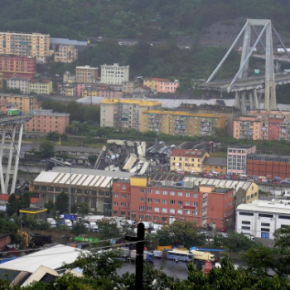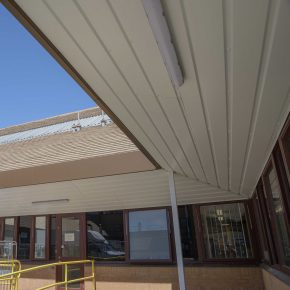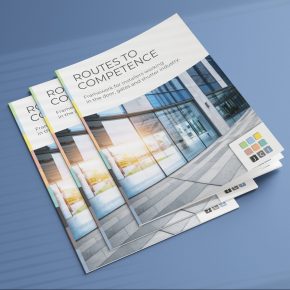
GENOA BRIDGE: Four decades in the making?
 Buildingtalk Online Editor Max Banner takes a look at what could of been behind the collapse of Genoa’s Morandi Bridge, which has so far tragically taken the lives of 43 people.
Buildingtalk Online Editor Max Banner takes a look at what could of been behind the collapse of Genoa’s Morandi Bridge, which has so far tragically taken the lives of 43 people.
A range of possible reasons have been raised for the bridge’s collapse, where cars travelling along it fell a horrifying 45 metres down.
Design flaws have been mentioned as a cause; the tendons on the Morandi bridge are made of reinforced concrete, which contains steel. Steel rusts, meaning it is prone to weakening over time.
Some engineers have long expressed concerns about the concrete-encased stay cables, which are somewhat unusual and used by Morandi in a handful of his bridge designs, as opposed to more common steel cables.
Reinforcement work on the tendons with steel took place in the 1990s.
Morandi himself warned of a corrosion risk four decades ago; a report from 1979 recommended constant maintenance of the structure to remove all traces of rust and fill in exposed patches on the reinforcements.
The report produced 12 years after the bridge opened referred to a “well-known loss of superficial chemical resistance of the concrete” because of sea air and pollution from a nearby steel plant.
Mr Morandi, who died in 1989, had a strong belief the reinforced concrete bridge design was okay but referred to the “aggressivity” of the corrosion that was not seen in similar structures in different environments.
=====================
General wear and tear has been raised a possibility; was completed in 1967, and normally a bridge is designed to last for at least 100 years.
In December 2012, a public hearing into how to expand the local transport infrastructure saw Genoa’s city council discussed the state of the Morandi bridge, with an industry official warning the bridge could collapse ‘in 10 years’.
=====================
Heavy traffic on the bridge may have also contributed to its weakening, over which approximately 25 million vehicles pass per year – it carries a major artery, the A10, that serves the Italian Riviera and links northern Italy to France.
A considerable drop in investment in the country’s infrastructure, which falls behind other economies in western Europe, could also be scrutinised.
It is also important to note the collapse occurred amidst a storm and extremely strong winds.
Also, the motorway operator said work to improve the bridge’s foundation was being undergone at the time of the collapse, whereby it was being constantly monitored.
=====================
The government of Italy has ordered an investigation, but experts warn it is too soon to look at only one cause too severely and with many venting their frustrations at the those in positions of power themselves, this is likely to be a tragedy that will take some time to get answers to.
(Image courtesy of Reuters)
Latest news

26th April 2024
Alumasc Skyline and Rainwater package specified at Weston-super-Mare Hospital
A package of products from Alumasc Water Management Solutions (AWMS) has been used for the external refurbishment of the roofline at Weston General Hospital in Weston-Super-Mare.
Posted in Aluminium Products, Articles, Building Industry News, Building Products & Structures, Building Services, Building Systems, Case Studies, Cladding, Drainage Services, Drainage, Guttering, Soffits & Fascias, Fascias, Restoration & Refurbishment, Retrofit & Renovation, Roofs, Walls
26th April 2024
Hush Acoustics optimises fleet operations by securing FORS Gold accreditation
Hush Acoustics has invested in the safety and sustainability of its commercial vehicle fleet by achieving Gold status in the Fleet Operator Recognition Scheme (FORS).
Posted in Acoustics, Noise & Vibration Control, Articles, Building Industry News, Building Products & Structures, Building Regulations & Accreditations, Building Services, Ceilings, Facility Management & Building Services, Floors, Health & Safety, Insulation, Restoration & Refurbishment, Retrofit & Renovation, Site Preparation, Sustainability & Energy Efficiency, Walls, Waste Management & Recycling
26th April 2024
Safeguard Europe: Penetrating damp - how to diagnose the damage
As Safeguard gets ready to deliver another informative session of one of its most popular webinars, the company outlines some of the most common reasons for rain penetration through brickwork.
Posted in Articles, Bricks & Blocks, Building Industry Events, Building Industry News, Building Products & Structures, Building Services, Continuing Professional Development (CPD's), Damp & Waterproofing, Facility Management & Building Services, Information Technology, Posts, Render, Restoration & Refurbishment, Retrofit & Renovation, Seminars, Training, Walls
25th April 2024
ADSA: Competence Initiative Makes Progress
The Joint Competency Initiative (JCI), in which the Automatic Door Suppliers Association (ADSA) is involved, is finalising its first framework for installers within the door, gates and shutter industry.
Posted in Access Control & Door Entry Systems, Architectural Ironmongery, Articles, Building Associations & Institutes, Building Industry Events, Building Industry News, Building Products & Structures, Building Regulations & Accreditations, Building Services, Continuing Professional Development (CPD's), Doors, Facility Management & Building Services, Health & Safety, Innovations & New Products, Publications, Research & Materials Testing, Restoration & Refurbishment, Retrofit & Renovation, Security and Fire Protection, Site Preparation
 Sign up:
Sign up: